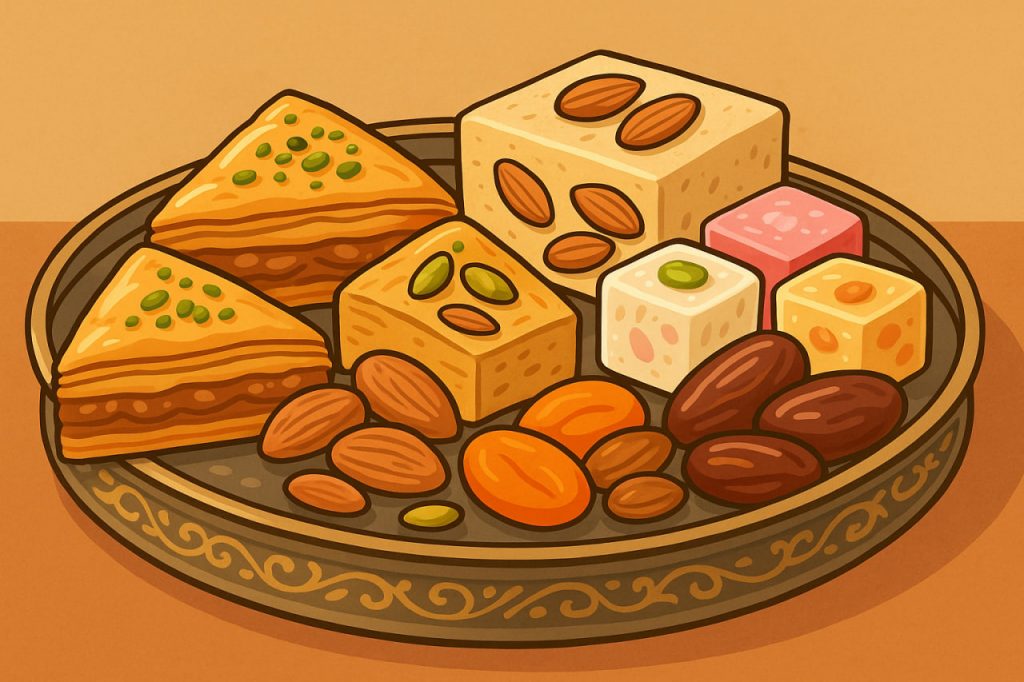Eastern sweets are famous worldwide for their unique flavors, rich traditions, and cultural symbolism. Originating from regions such as the Middle East, Central Asia, Turkey, Persia, and India, these desserts combine nuts, fruits, honey, and spices into delightful treats. While they are often high in sugar, many of them also include nutrient-rich ingredients that can benefit health when eaten in moderation.
Popular Types of Eastern Sweets
- Baklava
- A layered pastry made from filo dough, filled with walnuts, pistachios, or almonds, and soaked in honey or syrup.
- Origin: Turkey and surrounding regions.
- Health note: Provides healthy fats and antioxidants from nuts but should be consumed sparingly due to high sugar.
- Halva
- A dense, sweet confection made from sesame paste (tahini) or semolina.
- Variants exist across the Middle East, India, and Eastern Europe.
- Health note: Sesame seeds are rich in calcium, magnesium, and healthy oils.
- Lokum (Turkish Delight)
- A chewy sweet flavored with rose, lemon, or pomegranate and often filled with nuts.
- Origin: Ottoman Empire.
- Health note: Lower in fat but usually high in sugar; nut-filled versions provide more nutrients.
- Chak-Chak
- A traditional Tatar dessert made from fried dough pieces stuck together with honey.
- Origin: Central Asia and Russia.
- Health note: Rich in honey’s antioxidants but still calorie-dense.
- Rahat and Sherbet-based sweets
- Syrupy, fruit-flavored confections often served during celebrations.
- Provide quick energy but minimal long-term nutrients.
- Dry fruit and nut mixes (Ajwa dates, stuffed figs)
- Dates, figs, and apricots often stuffed with almonds, walnuts, or pistachios.
- Health note: Naturally sweet and rich in fiber, vitamins, and minerals, making them healthier than processed sweets.
Health Benefits of Ingredients in Eastern Sweets
- Nuts (pistachios, walnuts, almonds) – provide protein, omega-3 fatty acids, vitamin E, and antioxidants.
- Sesame (tahini in halva) – supports bone health and heart function.
- Honey – contains natural antioxidants and antibacterial properties.
- Dried fruits (dates, figs, apricots) – rich in fiber, iron, and natural sugars for energy.
- Spices (cardamom, cinnamon, rosewater) – aid digestion and provide anti-inflammatory effects.
Balance Between Pleasure and Health
While Eastern sweets often use nutrient-rich ingredients, they are still high in sugar and calories. Moderation is key:
- Choose nut- or fruit-based varieties for better nutrition.
- Prefer honey-sweetened versions over refined sugar.
- Enjoy small portions alongside a balanced diet.
Conclusion
Eastern sweets such as baklava, halva, and lokum are more than desserts—they are part of cultural identity and history. Their ingredients, especially nuts, seeds, honey, and dried fruits, provide valuable nutrients. However, remember to read the ingredients of these sweets, as they often contain many other unhealthy ingredients in addition to sugar.
The best way to make these delicious sweets is at home, without sugar or other harmful additives.
Glossary
- Baklava – a layered pastry with nuts and syrup.
- Halva – a dense sweet made from sesame or semolina.
- Lokum (Turkish Delight) – chewy, flavored sweet with nuts or fruit extracts.
- Antioxidants – substances that protect cells from damage.
- Moderation – controlled consumption to avoid excess.


